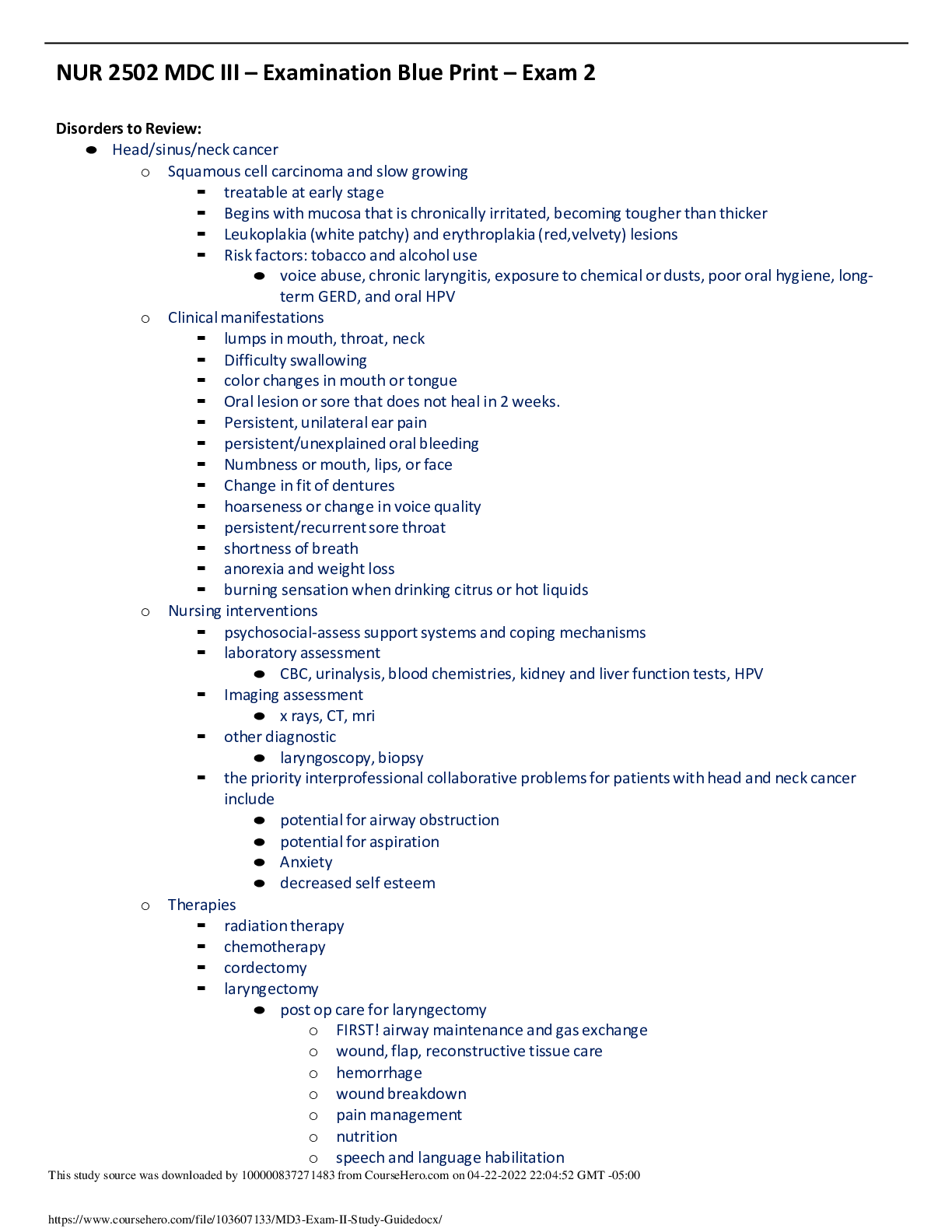*NURSING > EXAM > NUR2474 Pharmacology for Professional Nursing – Examination Blue Print – Final Exam_ LATEST,100% (All)
NUR2474 Pharmacology for Professional Nursing – Examination Blue Print – Final Exam_ LATEST,100% CORRECT
Document Content and Description Below
NUR2474 Pharmacology for Professional Nursing – Examination Blue Print – Final Exam_ LATEST Insulin: DM 1, DM 2, Gestational Diabetes HYPOGLYCEMIA IS A DANGEROUS ADVERSE EFFECT AND HIGH PRIORITY... FOR TREATMENT 1. What types of insulin are ordered before meals and at bedtime? Lispro and Regular are not ordered before bedtime; Lispro and Regular are usually given before meals; Lantus is given before bedtime; In the elderly especially, lantus is sometimes split into a morning and evening dose. Why? SUGAR DROPS OVERNIGHT and this can be DANGEROUS so NO NPH at bedtime; NPH is often given only in the morning. 2. What type of insulin is sometimes given at bedtime, has the longest duration of all the insulins, CANNOT BE MIXED WITH OTHER INSULINS, and for elderly patients is often split into two doses (one in the morning and one at bedtime)? Insulin Glargine (Lantus) is usually given once a day at bedtime. Elderly individuals often have their dose split in two and are administered one dose in the morning and one dose at night; In addition, sometimes insulin lispro is given in a sliding scale with a snack in the evening. It doesn’t last throughout the night-that’s what we want to avoid. *Insulin aspart protamine in combo with insulin aspart would NOT be given in the evening, as it lasts too long. *NPH would peak at exactly the WRONG TIME. Do not give that one at bedtime. Why is a nurse concerned for a beta-blocker/insulin combination? Beta Blockers can mask some of the symptoms of hypoglycemia What do you assess for? What symptoms could be concealed by taking a beta blocker while on insulin? • Symptoms of hypoglycemia: • Feeling shaky. • Being nervous or anxious. • Sweating, chills and clamminess. • Irritability or impatience. • Confusion. • Fast heartbeat. • Feeling lightheaded or dizzy. • Hunger. You will need to know the following chart: Onset: When the medicine starts to work (when the blood sugar is going to start to go down). Peak: Usually when the medicine is at its highest level, and you get the highest effect (in this case it equates to the times when you see the lowest blood sugars). Duration: How long the medication is going to last in effectiveness (how long is it going to affect blood sugars). MOST ORAL ANTI-DIABETICS (ORAL HYPOGLYCEMICS): Type 2 Diabetes, Most do not work for type 1 diabetes, Don’t risk it with babies we use regular insulin for gestational diabetes. Glipizide (Glucotrol): o How does it work? is in a class of medications called sulfonylureas. Glipizide lowers blood sugar by causing the pancreas to produce insulin (a natural substance that is needed to break down sugar in the body) and helping the body use insulin efficiently. o What diagnosis is it effective for (be specific)? Type 2, less than 5 years, no end organ damage, young enough o What classification(s) does it fit into? Oral hypoglycemic, Anti-diabetic, o What are the side/adverse effects? Hypoglycemia, diarrhea.constipation, nausea, vomiting, upset stomach, loss of appetite. Headache, weight gain, o What are contraindications? o low blood sugar. o pituitary hormone deficiency. o a condition where the adrenal glands produce less hormones called Addison's disease. o glucose-6-phosphate dehydrogenase (G6PD) deficiency. o hepatic porphyria. o a type of blood disorder where the red blood cells burst called hemolytic anemia. o alcoholism. o o Are there drug-drug interactions? o Do not take if allergic to sulfa o Are there drug-alcohol interactions? Do not take with alcohol o Are there drug-food interactions? Take with breakfast o Please note that this person will still need to be checking their BS at least once a day Metformin o How does it work? works by reducing the amount of sugar your liver releases into your blood. It also makes your body respond better to insulin. o What diagnosis is it effective for (be specific)? Type 2, less than 5 years, no end organ damage, young enough o What classification(s) does it fit into? Oral hypoglycemic, Anti-diabetic o What are the side/adverse effects? Can be harsh on end organs, esp. kidneys, . It's best to take metformin with a meal to reduce the side effects. IF SOMEONE IS GOING TO HAVE CONTRAST FOR A CT: THE METFORMIN IS STOPPED PRIOR TO HAVING THE CONTRAST. If they are taking metformin, and they come into an ER and a CT with contrast is ordered, do not blindly send the patient to CT, LET THE PROVIDER KNOW AND THEY WILL ORDER IT WITHOUT CONTRAST. Since it is so hard on the kidneys, drink plenty of water. o What are contraindications? Kidney disease, heart attack; stroke; diabetic ketoacidosis (blood sugar that is high enough to cause severe symptoms and requires emergency medical treatment); a coma; or heart or liver disease Acarbose: o How does it work? What diagnosis is it effective for (be specific)? by slowing the action of certain chemicals that break down food to release glucose (sugar) into your blood. Slowing food digestion helps keep blood glucose from rising very high after meals o What classification(s) does it fit into? alpha-glucosidase inhibitors, which also includes miglitol (Glyset); anti-diabetic, oral hypoglycemic agent o What are the side/adverse effects? Diarrhea o What are contraindications? hypersensitivity, diabetic ketoacidosis, liver cirrhosis, inflammatory bowel disease, or colonic ulceration o Are there drug-drug interactions? Avoid taking a digestive enzyme such as pancreatin, amylase, or lipase at the same time you take acarbose. o Are there drug-alcohol interactions? Do not mix, it may cause sudden hypoglycemia o Are there drug-food interactions? No grapefruit juice D50W Emergency Med Given IV o How does it work? What diagnosis is it effective for (be specific)? Direct Sugar for Body o What classification(s) does it fit into? Hyperglycemic agent o What are the side/adverse effects? Hyperglycemia Glucagon Emergency Med Given IM or SUBQ o How does it work? What diagnosis is it effective for (be specific)? Glucagon's role in the body is to prevent blood glucose levels dropping too low. To do this, it acts on the liver in several ways: It stimulates the conversion of stored glycogen (stored in the liver) to glucose, which can be released into the bloodstream. This process is called glycogenolysis. o What classification(s) does it fit into? Hyperglycemic agents o What are the side/adverse effects? Hyperglycemia Levothyroxine: o How does it work? What diagnosis is it effective for (be specific)? Hypothyroid. Works as hormone replacement. o What classification(s) does it fit into? Thyroid hormone replacement therapy o What are the side/adverse effects? Insomnia, tremors, increased heart rate (might be overtreatment, so contact provider) o What are contraindications? o Who should not take Levothyroxine Solution? • overactive thyroid gland. • thyrotoxicosis crisis. • diabetes. • pituitary hormone deficiency. • a condition where the adrenal glands produce less hormones called Addison's disease. • osteoporosis. • a condition of weak bones. • decreased calcification or density of bone. o What laboratory value is used to manage dosing and hypothyroidism management? TSH, T3, T4 o What time of day should a person take this medication and why? Early in am. Usually 6am. People should really take this at least 30 minutes before breakfast. o Are there drug-drug interactions and what are they? Heartburn medications (PPI, H2 blocker, antacids) interact so talk to MD before taking them with Levothyroxine, Iron must be taken four hours afterwards o Why is this medication important for a hypothyroid patient while pregnant? To avoid the negative neuro and psychiatric effects of not treating the the hypothyroidism. Sulfamethoxazole/Trimethoprim o How does it work? Separately, they are only bacteriostatic; together, they are bactericidal. What diagnosis is it effective for (be specific)? Really good for tough UTIs o What classification(s) does it fit into? Sulfa antibiotics Does this classification have many look alike/sound alike drugs? Yes. Many have the “sulfa” prefix o What are the side/adverse effects? Decreased appetite, N/V, painful or swollen tongue/spinning sensation, ringing in your ears, feeling tired, kidney stones o What prefix tells you this belongs to the classification it is in? Sulfamexazole o Why does one teach patients to drink plenty of water with this? To prevent the formation of kidney stones. Cephalexin, Cefoxitin: o How does it work? bactericidal and have the same mode of action as other β-lactam antibiotics (such as penicillins), but are less susceptible to β-lactamases. Cephalosporins disrupt the synthesis of the peptidoglycan layer forming the bacterial cell wall. o What diagnosis is it effective for (be specific)? Strep (and other infections) o What classification(s) does it fit into? Cephalosporins Does this classification have many look alike/sound alike drugs? Many of these start with ceph and cef and are famous for error because of the look alike/sound alike issue. o What are the side/adverse effects? N/V/D o How does it interfere with warfarin? Cephalexin causes warfarin levels to be higher and make the INR even higher. This may mean that the warfarin needs reduction while on cephalexin, but the provider will look at the INR before making this determination. Anticipate this, so that it can be watched closely. o Why is it important to observe for side effects if someone has had an allergic reaction to penicillins? This is not a penicillin. Observe them. Sometimes, a cross allergy can occur. Metronidazole: o How does it work? What diagnosis is it effective for (be specific)? This is given for C. Diff (clostridium difficile) which is often induced by other antibiotics like cephalosporins, penicillins, etc…. When the c. diff infection starts, they discontinue the other antibiotic and can start one on metronidazole. o What classification(s) does it fit into? Nitroimidazoles o What are the side/adverse effects? Dizziness, headache, stomach upset, nausea, vomiting, loss of appetite, diarrhea, constipation, or metallic taste in your mouth may occur o Can it be mixed with alcohol? Why or why not? No. Effects of this can include a sudden drop in blood pressure, rapid heart rate, and liver damage. Acyclovir: o How does it work? Antiviral What diagnosis is it effective for (be specific)? Herpes o What classification(s) does it fit into? Antiviral (many of these end with the suffix –vir) o What are the side/adverse effects? Serious: Kidney Failure, Hepatitis…Common:Agitation, Diarrhea, Dizziness, Drowsiness, Hair Loss, Headache, Irritation Of The Stomach Or Intestines, Muscle Pain, Nausea, Stomach Cramps, Vomiting o Pregnancy implications? Can be used during pregnancy. The risk of passing it on to baby is high the control of an outbreak reduces that risk. Nephrotoxicity (labs that indicate kidney function: creatinine, BUN). How can one decrease the risk of kidney damage while on this medication? Hydrate the client for two full hours after the infusion to reduce the risk of kidney damage. Amoxicillin How does it work? β-lactam antibiotics disrupt the synthesis of the peptidoglycan layer forming the bacterial cell wall. o What diagnosis is it effective for (be specific)? Strep etc… o What classification(s) does it fit into? Penicillins Does this classification have many look alike/sound alike drugs? Many have the suffix -cillin o What are the side/adverse effects? Anaphylaxis, rash, N/V/D, abd pain o What are contraindications? Previous allergy to any penicillin o If one is allergic to one “cillin,” meaning a penicillin-like drug, they are allergic to all “cillins.” What is a cross-allergy? If one is allergic to any ‘-cillin” o What would be signs and symptoms of mild allergy and how is this mild allergy treated? Rash, treated with diphenhydramine (and changing antibiotic) What would be signs and symptoms of a severe reaction and how is it treated? Anaphylaxis: Epinephrine FIRST (most correct); then, it can be followed by diphenhydramine, and solu-medrol Please note that allergies to penicillins are VERY common. Ciprofloxacin o How does it work? interferes with its DNA replication. What diagnosis is it effective for (be specific)? Pneumonia, UTI o What classification(s) does it fit into? Fluoroquinolone Does this classification have many look alike/sound alike drugs? Many end with the suffix “-floxacin.” o What are the side/adverse effects? Report heel pain to provider; fluoroquinolones are famous for causing tendon rupture and this can happen with the achilles o What are contraindications? Diabetes, C. Diff, low seizure threshold o What is the risk for tendons with this classification? o Do not take calcium at the same time as most antibiotics. It tends to hug (decrease absorption of the ciprofloxacin) Take the calcium either six hours before or two hours after taking the ciprofloxacin. Itraconazole: • How does it work? Antifungal What diagnosis is it effective for (be specific)? Fungal infections like tinea corporis • What classification(s) does it fit into? Antifungal • What are the side/adverse effects? • Drug-Drug interactions: If this is being taken with cimetidine (and other H2 blockers), make sure the H2 blocker, like cimetidine, is given at least two hours after the itraconazole • Please note that when one is taking this medication topically for tinea corporis, nurses should teach the patient to continue the medication for at least one week after the symptoms have cleared. Cimetidine o How does it work? H2 blockers, Reduces the amount of acid (H+) in the stomach What diagnosis is it effective for (be specific)? GERD o What classification(s) does it fit into? H2 blockers o What are the side/adverse effects? Headache, diarrhea, dizziness, drowsiness, breast enlargement o What suffix tells you this belongs to its classification? -tidine o Why does this drug interfere with many other drugs and needs to be given at a different time from many other medications. It changes the pH and the absorption of different drugs. Pantoprazole o How does it work? Proton Pump Inhibitor; Reduces acid in the stomach What diagnosis is it effective for (be specific)? GERD o What classification(s) does it fit into? Proton Pump Inhibitor Does this classification have many look alike/sound alike drugs? o What are the side/adverse effects? Headache, dizziness, stomach pain, gas, nausea, vomiting, diarrhea, joint pain, fever, rash, cold symptoms o Administration implications? Take before eating. It is prophylactic. Sucralfate o How does it work? It works by coating the stomach to protect it from its own acid What diagnosis is it effective for (be specific)? Gastric/Peptic Ulcer o What classification(s) does it fit into? Mucosal protectant o What are the side/adverse effects? Difficulty breathing, pink/frothy sputum, N/V o Administration implications? Usually, you DO NOT take this with other meds. Estrogen Therapy: o How does it work? What diagnosis is it effective for (be specific)? o What are the side/adverse effects? Are there specific routes that have less side effects? Estrogen exerts less side effects when given transdermally. The nurse should discuss that there is a risk of stroke, deep vein thrombosis, and ovarian cancer with estrogen therapy. o What are contraindications? o Why might a patient be prescribed an estrogen/progestin combination rather than just estrogen? The addition of progestin actually decreases the risk estrogen poses on one developing endometrial cancer. Compare and contrast the side/adverse effects of the two. o How is transdermal estrogen spray applied? It is sprayed to the inner forearm. Testosterone Gel 1% o How does it work? What diagnosis is it effective for (be specific)? hypogonadism o What are the side/adverse effects? o What are contraindications? o How is it applied to be most effective? Avoid direct skin-to-skin contact with spouse where the medication was applied; do not apply it to genitals; blood will be drawn in 14 days; Wait five to six hours after application to swim Doxazosin o How does it work? What diagnosis is it effective for (be specific)? Enlarged prostate Sildenafil: o What medication may cause profound hypotension if taken with it? Nitroglycerin. The two are not to be taken together. Naloxone: o How does it work? Opioid reversal. What diagnosis is it effective for (be specific)? Reverses the effects of opioids. o What classification(s) does it fit into? Opioid antagonist Ibuprofen o How does it work? Anti-inflammatory What diagnosis is it effective for (be specific)? Pain, Fever o What classification(s) does it fit into? NSAIDS o What are the side/adverse effects? Bleeding o Pregnancy implications? Do not take during pregnancy. Okay to take while breastfeeding. Fexofenadine o How does it work? Antihistamine What diagnosis is it effective for (be specific)? Seasonal Allergies. o What classification(s) does it fit into? Second generation antihistamine o What are the side/adverse effects? Back pain, small amount of dry mouth, tired (but much less tired than first generation antihistamines). o How long does it last? There is a 24h and 12h. Provider may give you the option of taking it once or twice a day. o Which one is dosed once a day and which one is dosed twice? These are over-the-counter, and are taken either once a day or twice a day. There are two types. Hyrdroxyzine: o What classification(s) does it fit into? First-generation antihistamine o Why would one not mix this drug with other CNS depressants? They are both sedating. Morphine Sulfate: • How does it work? What diagnosis is it effective for (be specific)? Opioid receptors (mu) are located in the brain, spinal cord, and digestive tracts; These are the receptors that opioids bind to and decrease pain • What classification(s) does it fit into? Does this classification have many look alike/sound alike drugs? Opioids, Narcotics; • What are the side/adverse effects? Famous ones: Decrease respirations, Decrease CNS, Constipation, Decreased Blood Pressure o One should hold morphine if respirations are 10 bpm, if the patient’s LOC is compromised from the narcotic, and/or if oxygen saturations are low. • What is the reversal agent? Naloxone • What are the signs and symptoms of overdose? Pinpoint pupils, decreased respirations, Neurological abnormalities (confusion) • What does the nurse need to assess prior to administration of morphine? Airway, Breathing, Circulation (In that order) Which is the most important? Airway, Breathing • When would one evaluate morphine’s effectiveness after administering it IV? 15 minutes after administration • When would one evaluate oral medication effectiveness? 45 minutes to 1 hour • PREGNANCY: DURING CHILDBIRTH, IF THE MOTHER IS GIVEN MORPHINE (OR ANY OTHER OPIOID) MAKE SURE TO WATCH FOR RESPIRATIONS. • What is dependence? Tolerance? Addiction? These things affect children and adults. o Dependence: Physical Dependence is most often what they are referring to. Characterized by symptoms of tolerance and withdrawal. Physical withdrawal symptoms may occur. o Tolerance: Over time, one will require more of the same drug to achieve the same effect. o Addiction: Change in behavior cause by the biochemical changes in the brain after continued substance abuse. person may act irrationally, seek the drug even though it causes awful symptoms and people may act irrationally when they do not have the drug in their system (often to obtain it). o Parents are in charge of this medication for minors. • What are ethical implications of Patient Controlled Analgesia (PCA) pumps? The individual receiving it must be fully alert and oriented (legally making decisions). Who can press the button? The patient only. NOT FAMILY AND NOT THE NURSE. What is required for a person to be competent to have a PCA (patient controlled analgesia) pump? • Because urine retention and drowsiness (fall risk) are a problem with PCA pumps and post- operative pain, what intervention may be necessary to decrease risk of falling while keeping urine off of the patient’s skin? Hint: You must be able to maintain sterility while inserting it. Urinary Catheter. Glucocorticoids (carry medical alert bracelet) Examples: Solu-Medrol; Solu-Cortef; hydrocortisone; prednisone; prednisolone; dexamethasone; fluticasone 1. How do they work? Corticosteroid works naturally in the body during times of stress; suppress inflammation; suppressing inflammatory responses in the body 2. What are their side/adverse effects? Adrenal insufficiency, Osteoporosis, Infection Risk, HYPERglycemia, psychologic disturbances, interferes with sleep, peptic ulcer, healing process is delayed, Cushing’s Syndrome, glucose intolerance, fluid and electrolyte disturbances, cataracts and glaucoma; May need a gastric acid suppressor; May have decreased ability to heal wounds. Wounds will take longer to heal while on these, growth inhibition. What are long term effects? What can happen with abrupt discontinuation? If discontinued suddenly, adrenal insufficiency can happen (may need to restart); if you quit taking these and do get adrenal insufficiency you may need to take glucocorticoids again while under stress 3. What happens to one’s blood sugars when on systemic glucocorticoids? Hyperglycemia 4. Please note that the nurse should report an elevated temperature for someone who is taking Glucocorticoids. While on Glucocorticoids, people will often have an elevated white count (high WBCs), but their immune system is still depressed. What is Cushing’s Syndrome? • weight gain. • thin arms and legs. • a round face. • increased fat around the base of the neck. • a fatty hump between the shoulders. • easy bruising. • wide purple stretch marks, mainly on the abdomen, breasts, hips, and under the arms. • weak muscles. How can glucocorticoids contribute to gastric/peptic ulcers? Decreased healing What do glucocorticoids do to your white count, and why is one immunocompromised even though this happens to the white blood cell count? Elevate White count, but makes them not as functional so one becomes immunocompromised. What happens to muscles and bones on long term therapy. Decreased density and growth. Aspirin: o How does it work? Makes a person bleed easier by making platelets slippery. Anti-inflammatory What diagnosis is it effective for (be specific)? Pain, MI prophylaxis o What classification(s) does it fit into? NSAID o Why would a person need to stop taking aspirin for a period of time prior to surgery? One would anticipate the provider ordering that the patient stop taking the aspirin one week prior to surgery. The risk of bleeding during surgery is high. o Teach a client taking high-dose aspirin: a. Gastric erosion can occur. b. Report signs of bleeding: bleeding gums, tarry stools, blood in urine, excessive bruising. c. Report ringing in the ears by calling your provider if it occurs. d. High-dose aspirin can be nephrotoxic (hard on the kidneys) e. Can cause Reye Syndrome in children. Not for children, usually. Probenecid, Allopurinol, and Colchicine: o Are they used for acute gout or prophylaxis (chronic)? Probinecid-chronic; Allopurinol-chronic; Colchicine-can be used in acute cases, but also can be utilized as prophylactic Lithium: o What is it used for and how does it work? Lithium helps reduce the severity and frequency of mania. It may also help relieve or prevent bipolar depression. It works by changing the chemical (ion) balance around nerve cells. o What are dangerous and common side effects/adverse effects? It can make a person drowsy, especially if toxic. It should never cause sedation. o What are normal lithium levels? 0.6 - 1.2 mmol/L What symptoms may one see if a person has toxic levels? nausea, diarrhea, shaking of the hands, dizziness, twitching, seizures, slurred speech, confusion, or increase in the amount of urine Methylphenidate: o What is it used for and how does it work? ADHD, normalizes brain chemicals by inhibiting the reuptake of dopamine and norepi; increased dopaminergic and noradrenergic activity in the prefrontal cortex o What are dangerous and common side effects/adverse effects? Increased heart rate, insomnia, weight loss, o Teach Parents? Keep the medication in a safe place. It is a controlled substance. Phenytoin: o What is it used for and how does it work? It is used to lower the seizure threshold to decrease o What are dangerous and common side effects/adverse effects? a. Patient should be taught to brush after every meal and floss teeth daily. o What are normal phenytoin levels? Approximately 10 and 20 µg/mL What symptoms may one see if a person has toxic levels? Decreased CNS Vancomycin: o What is it used for and how does it work? Can be used with MRSA, bactericidal antibiotic o What are dangerous and common side effects/adverse effects? Famous for causing kidney problems; it can damage tissue surrounding the vein through extravasation o What laboratory data would suggest calling the provider and anticipating a less toxic medication? High BUN, High Creatinine, Low GFR (kidney) o What classification(s) does it fit into? Glycopeptide antibiotics Echinacea: o How does it work? Immune enhancer What diagnosis is it effective for (be specific)? Colds o What classification(s) does it fit into? Herbal o What are the dangerous and common side/adverse effects? Allergies o Drug-Supplement Interactions? Works against immunosuppressants, so one shouldn’t take the two together, usually Atenolol: o What is it used for and how does it work? Hypertension, HF o What classification is it in? Beta Blocker o What are dangerous and common side effects/adverse effects? Famous for bradycardia and hypotension, watch those with asthma or COPD closely o What is the suffix that identifies this as being in the particular classification it is in? -olol o What two vital signs can lower dangerously and need to be assessed prior to taking atenolol? BP and HR Why would a nurse hold this medication (or any medication in this classification)? BP less than 90/50 and/or HR less than 60 o What is the suffix that tells you the classification of this medication? -olol Digoxin: o What is it used for and how does it work? HF o What classification is it in? Digitalis glycosides o What are dangerous and common side effects/adverse effects? Bradycardia, o What are common symptoms of toxic digoxin levels? Visual disturbances (yellow or green halos or other visual blurring, etc…), very low pulse, nausea o What vital sign is important to teach to patients before taking digoxin? Nurses teach patients to take their own pulse. o What anatomical site will the nurse use when checking the patient’s pulse? Apical pulse o When would a nurse hold this medication and call the provider? If pulse is less than 60. If a patient is having visual disturbances, like “halos” (yellow or greenish, usually, but not always) Nifedipine: o What is it used for and how does it work? Caclium Channel Blocker; used for disrhythmias, HF, vasospasm (brain) etc… o What classification is it in? Caclium Channel Blocker o What are dangerous and common side effects/adverse effects? Common & Dangerous: Constipation, Fluid retention in feet o Administration considerations? Nifedipine can come as an extended released. Extended release medications should never be crushed. Grapefruit and grapefruit juice will cause elevations of this medication. NO GRAPEFRUIT WITH CALCIUM CHANNEL BLOCKERS. Lithium: o What is it used for and how does it work? It treats bipolar mania and depression (the depression part is controversial, but in our class, we’ll say it treats the depression, too). o What are dangerous and common side effects/adverse effects? o What are normal lithium levels? What symptoms may one see if a person has toxic levels? Nitroglycerin: o What is it used for and how does it work? It works by relaxing the blood vessels and increasing the supply of blood and oxygen to the heart while reducing its work load (through preload reduction and a reduction in systemic vascular resistance). o What classification is it in? nitrates o What are dangerous and common side effects/adverse effects? Hypotension (which warrants holding it); PLEASE NOTE THAT EVERY ONE WHO GETS THIS MEDICATION WILL GET A HEADACHE AND THAT IS EXPECTED. YOU WILL NOT HOLD IT FOR A HEADACHE. o Why would a person need to sit down prior to taking it? So they don’t fall if their blood pressure drops significantly. o How many minutes apart is nitroglycerin given? Five minutes o How many nitroglycerin should one give before anticipating that a nitro drip be started? o MAKE SURE NOT TO USE NITROGLYCERIN WITH PATIENTS WHO ARE TAKING SILDENAFIL (AKA: VIAGRA). They will experience a sudden and possibly deadly drop in blood pressure. Furosemide: o What is it used for and how does it work? Used for HF, diuresis o What classification is it in? Loop Diuretics o What are dangerous and common side effects/adverse effects? Hypotension and Hypokalemia o Why is an individual at increased risk of falling if Lasix is given late in the day/evening/night? In other words, why is it preferable to give this during the day? This should be taken at 0800 as to not interfere with sleep. That way, the individual will be voiding more often during the day, rather than throughout the night which decreases the risk of the individual falling and gives them better sleep. o What would one include in patient teaching for this medication (important vital signs, weight monitoring, electrolyte symptoms)? Weigh yourself daily and if you gain greater than two pounds, contact your provider. o Why would a nurse hold this medication? (Vital signs and a very important electrolyte)? Hypotension and Hypokalemia would warrant holding this med; Low potassium (K<3.5), Low BP (sBP<90) o Spironolactone: o What is it used for and how does it work? Potassium Sparing Diuretic o What classification is it in? Potassium Sparing Diuretic o What are dangerous and common side effects/adverse effects? Hypotension and hyperkalemia o Why is an individual at increased risk of falling if spironolactone is given late in the day/evening/night? In other words, why is it preferable to give this during the day? 0800. Reduce fall risk from getting up to pee at night. o What would one include in patient teaching for this medication (important vital signs, weight monitoring, electrolyte symptoms)? If you gain greater than 2-3 lbs in a day, contact your provider. o Why would a nurse teach a patient to avoid Mrs. Dash (salt substitute) while taking spironolactone? Avoid salt substitutes as they are high in potassium (Mrs. Dash). o Why would a nurse hold this medication? (Vital signs and a very important electrolyte) High potassium (K>5), Low BP (sBP<90) Warfarin: o What is it used for and how does it work? Anticoagulant and it makes one more likely to bleed. o What classification is it in? anticoagulant o What are dangerous and common side effects/adverse effects? Excessive bleeding o Why is an INR (Pt/INR) important to know with this medication? What is a normal INR less than 2.0 versus a therapeutic INR? 2-3 What might one assess if one’s blood was too thin? Bruises, dark tarry stools, at risk for head bleed if fall occurs and they hit their head. Signs of bleeding: call the provider and the provider will guide the next move. o Teach the patient to : avoid alcohol, avoid herbals unless directed by provider, be consistent with leafy greens, get INR checked with any antibiotics o VITAMIN K: is the reversal agent for warfarin Enalapril: o What is it used for and how does it work? ACE inhibitor (Inhibits ACE in the Angiotensin-Renin process) o What classification is it in? What suffix makes this part of that classification? ACE Inhibitors o What are dangerous and common side effects/adverse effects? A persistent, dry cough, when uncomfortable, will cause the provider to change the prescription. Angioedema also can happen, and is famous with –prils (ACE inhibitors). If this happens, the patient will DEFINITELY be switched. –sartans (angiotensin 2 inhibitors) usually are the replacement. Candosartan (angiotensin 2 inhibitor) Monteleukast Sodium o What is it used for and how does it work? Leukotriene blocker, used to prevent asthma o What classification is it in? leukotriene blocker o What are dangerous and common side effects/adverse effects? Anxiety and suicidality; o Is it prophylactic or rescue? Prophylactic (preventative) Theophylline: o What is it used for and how does it work? Used for asthma, opens airways o What classification is it in? xanthines o What are dangerous and common side effects/adverse effects? tachycardia o Is it prophylactic or rescue? rescue Albuterol: o How does it work? What diagnosis is it effective for (be specific)? Asthma as a rescue inhaler, assess lungs first and you may hear wheezing before and clear lungs after (that would be the hope) o What classification(s) does it fit into? Bronchodilators, Sympathetic (Adrenergic) o What are the side/adverse effects? Tachycardia; Feeling jittery; Dry mouth o How does using albuterol as directed during pregnancy to decrease the chance of stillbirth? Good oxygenation of the baby is VERY important. Stopping albuterol doubles the chance of stillbirth. Ipratropium bromide: o How does it work? What diagnosis is it effective for (be specific)? Blocks acetylcholine, opens airways o What classification(s) does it fit into? Anticholinergic o What are the side/adverse effects? Dry mouth, headache, hoarseness Trimethoprim/Sulfamexazole: o What is it used for and how does it work? Antibacterial (sulfonamides are only bacteriostatic). Please note that sometimes a more expensive medication, like the trimethoprim/sulfamexazole product, is ordered as it is bactericidal in this combination. o What classification is it in? Trimethoprim is an antifolate antibacterial agent that inhibits bacterial dihydrofolate reductase (DHFR), a critical enzyme that catalyzes the formation of tetrahydrofolic acid (THF) - in doing so, it prevents the synthesis of bacterial DNA and ultimately continued bacterial survival. Sulfamethoxazole is an anti-bacterial sulfonamide, a "sulfa" drug. It disrupts the production of dihydrofolic acid while trimethoprim disrupts the production of tetrahydrofolic acid. Dihydrofolic acid and tetrahydrofolic acid are forms of folic acid that bacteria and human cells use for producing proteins. o What are dangerous and common side effects/adverse effects? Loss of appetite, spinning sensation, swollen tongue, N/V, ringing in your ears, tiredness, insomnia, JAUNDICE (liver), sore throat o Specific Patient Teaching? Drink 8-10 glasses of water each day. Propanolol and Metoprolol: o How does it work? Anti-adrenergic; Beta blocker What diagnosis is it effective for (be specific)? o What are the side/adverse effects? Lowered blood pressure and heart rate o Masks the symptoms of hypoglycemia. o What are contraindications? Hypotension and/or bradycardia (sBP <90 or HR <60) Ma huang: o How does it work? This is often taken by some for weight loss. o What are their dangerous and common side effects? Can increase blood pressure and heart rate (negative effect on your heart). Garlic: o How does it work? May lower blood pressure. o What are their dangerous and common side effects? Antiplatelet properties to increase risk of bleeding. Ginkgo Biloba and Ginseng: o How does it work? Improve intellectual performance o What are the dangerous side effects? Risk of bleeding and could interfere with any medication involved with coagulation. St. John’s Wort: o Used for depression and works like a mild SSRI o Can cause Serotonin Syndrome if taken with SSRIs or around the same time as an SSRI. Acetaminophen (Tylenol) : 1. How does it work? Prostaglandins 2. What are adverse effects? Hepatic necrosis with overdose; Severe poisoning (overdose) can progress to hepatic failure and death; Early Symptoms are N/V/D, abdominal pain/discomfort, sweating 3. What happens with overdose? What are early symptoms? Late symptoms? Severe poisoning (overdose) can progress to hepatic failure and death; Early Symptoms are N/V/D, abdominal pain/discomfort, sweating Late symptoms can include jaundice (liver failure) and changes in LOC 4. What liver enzymes would be checked if there was an overdose? LFTs (AST, ALT, Bilis) LFTs=Liver Function Tests AST, ALT=Amino…transferases, Bilirubin. If they are rising, that is a bad sign and if they are falling that is a good sign. 5. What medication is used to thwart some of the side effects of overdose (not completely an antidote, but sometimes called an antidote)? Acetylcysteine (Mucomyst) IV Which organ is it protecting the most? Liver, but it also is a kidney protector 6. What signs and symptoms would one see if there was a patient with liver damage from an acetaminophen overdose? Severe poisoning (overdose) can progress to hepatic failure and death; Early Symptoms are N/V/D, abdominal pain/discomfort, sweating 7. What liver enzymes would be checked if there was an overdose? LFTs (AST, ALT, Bilis) 8. What signs and symptoms would one see if the individual is improving? Decreased jaundice, Decreased LFTs (AST, ALT, Bilis), Decrease of these: N/V/D, abdominal pain/discomfort, sweating Diphenhydramine (Benadryl): o How does it work? Decrease histamine response. What diagnosis is it effective for (be specific)? Mild to Moderate Allergic Reactions Why is it not the first drug given for anaphylaxis (1st given is epinephrine), but it is the first drug given for hives? Hives are a mild to moderate allergic reaction. o Please note: DO NOT TAKE ANTIHISTAMINES WITH ALCOHOL (drowsiness with first generations, and liver enzymes with second generations) o What classification(s) does it fit into? First Generation Antihistamine o What are the side effects? Drowsiness, Dry mouth How can one mitigate some of the side effects? Tell them about the fact that they may become drowsy. o Which of the following are first generation and which are second generation anti-histamines? Compare and contrast them. First Gen Hydroxizine, Diphenhydramine, Deloratidine, Loratidine, Fexofenadine, Certrazine Second Gen o What is the difference between first generation and second generation anti-histamines? Second generation anti-histamines do not cause as much drowsiness and often allow for longer duration ***Please note that fexofenadine has two forms. One is 24h and one is 12h. The provider may give the client the choice between taking it once a day and taking it twice a day. Odds and Ends: 1. Why should antihistamines be avoided during pregnancy? They are category C. 2. What does it mean that two medications are not compatible in IV tubing? What does that mean for the nurse? If two drugs are incompatible in IV tubing (incompatible at the y site) that means they cannot go into the same line. If they are incompatable as admixture, then they are imcompatible if mixed in a bag. 3. What is infiltration? Leaking of IV fluid out of the vein. What is phlebitis? Inflammation of the vein (remember the cardinal signs of inflammation? Redness, swelling, heat, pain…. What is extravasation? Leaking of an IV drug out of the vein that can cause necrosis (death) to the tissue it leaks into. Compare and contrast these things. What are the nursing interventions one should take if an IV infiltrates, a vein succumbs to phleblitis from an IV/IV infusion? Seek and select a new site for IV infusion. 4. What symptoms could be assessed for the following ailments? If a patient begins to experience symptoms of an allergy to a medication (increased heart rate, fever, rash, etc…) be aware that you need to stop the medication and call the provider. a. Allergic reaction (mild) Rash b. Allergic reaction (severe) Anaphylaxis (with anaphylaxis, the provider is contact and epinephrine is administered; you may notice difficulty breathing, tight feeling in throat, low blood pressure. c. Redman syndrome: flushing, rash, pruritis, urticarial, elevated heart rate, decreased blood pressure; infusion-related reaction d. Rhabdomyelosis e. Hypoglycemia 5. Why is diarrhea so important to assess for in someone taking an antibiotic? Antibiotics can cause C. Diff. Many antibiotics can cause C. Diff: Clindamycin is one of them. 6. Why should one not have products high in calcium at the same time as most antibiotics? Calcium will “hug” the medication as it slides down the digestive tract. The person can still have milk products, but not at the same time. 7. Why are cough suppressants contraindicated with patients? Infants: Many have sedative effects and effect infants more than adults. All people: Coughing is a way to expectorate some of the virus or bacteria to decrease the load of disease in their lungs. It’s part of our innate immunity. Cough suppressants should really only be used for those who have a dry cough and have not been able to sleep for some time. 8. What is wrong with a person taking both Tylenol and Norco (hydrocodone/acetaminophen) or Percocet (oxycodone/acetaminophen) at the same time? Norco also has Tylenol in it (acetaminophen) and it could lead to overdose to take both. 9. A doctor will often order hepatic-metabolized drugs at a much lower dose for infants than adults. Why? A person with kidney disease or an elderly person who has many medications is at high risk for toxicity with those medications. The person also has a higher risk of further kidney damage. A serum creatinine should be performed. 10. Why would an individual be at higher risk for adverse effects from a drug if they had kidney disease? What labs would one look at? Why does increasing the number of these medications increase the risk of toxicity in a patient with kidney disease? A person with kidney disease or an elderly person who has many medications is at high risk for toxicity with those medications. The person also has a higher risk of further kidney damage. A serum creatinine should be performed. 11. Compare and Contrast Ipratropium and albuterol. 12. Know these concepts: Toxicity- a drug is toxic when its level is high enough to cause harm to a patient, Half-Life-time it takes for half the drug to be metabolized, distribution- , absorption, dissolution, elimination 13. Hypoglycemia (Know the Signs and Symptoms, Know when to hold insulin and call the provider. Know when to give orange juice vs. glucagon vs. D50W) tremors, pallor, agitation, confusion, headache, sweating 14. Allergic Reaction (What is the difference in treatment of a mild allergic reaction and an anaphylactic reaction? What are the signs and symptoms? 15. What is the difference between “Red Man Syndrome” and “Steven’s Johnson Syndrome?” What are they? 16. Know these terms and why the routes may be utilized: intrathecal, intraspinal, oral, buccal, sublingual, intramuscular, intravascular, rectal. Compare and contrast intrathecal and intraspinal. Why is intrathecal used so commonly in obstetrics? 17. Why are infants and the elderly at risk for toxicity (and subject to severe) symptoms of toxicity from numerous medications? Infants have low weight. Infants have immature liver and kidney. Elderly have degrading liver and kidney and are on multiple medications. Are there other factors that can lead to increased risk of toxicity and adverse reactions? Name them. Weight. Liver maturity or degredation. Kidney maturity or degredation. That’s why some meds are weight based and some are adjusted for age, kidney function, or liver function. 18. Please note that organs can be affected by toxic levels of drugs. Please monitor patients for end organ damage if toxic levels of a medication are reached. For example, if a Tylenol (acetaminophen) overdose occurs, one would watch for the effects on one’s liver (Tylenol is hard on the liver). 19. Definition of Bacteriostatic/Bactericidal Activity. The definitions of “bacteriostatic” and “bactericidal” appear to be straightforward: “bacteriostatic” means that the agent prevents the growth of bacteria (i.e., it keeps them in the stationary phase of growth), and “bactericidal” means that it kills bacteria. 20. PLEASE MAKE SURE TO KNOW THAT CALCIUM INHIBITS THE ABSORPTION OF MOST ANTIBIIOTICS; THEREFORE, CALCIUM CONTAINING PRODUCTS, LIKE MILK AND CALCIUM- CONTAINING ANTACIDS (ANY CATION CONTAINING ANTACIDS AND MANY CATIONS) CANNOT BE TAKEN AT THE SAME TIME. 21. ***Please note that pain during labor is treated with an epidural because this: a. Keeps the medication away from the placenta b. Infants’ blood-brain barriers, liver, and kidneys are not fully developed yet. c. Once born, the infant will not be able to tolerate and respiratory suppression will ensue. 22. Please remember that Tylenol is okay during pregnancy and during breastfeeding. Ibuprofen is NOT okay during pregnancy, but is fine while breastfeeding. 23. More infant stuff: a. Infants breastfeeding can become toxic if lipid soluble drugs are being taken by mom b. Immature kidneys cause slow excretion c. Immature livers slow metabolism d. Very sensitive to meds that affect the CNS. 24. Stuff that affects the physiological response to medications: gender, genetics, age 25. [Show More]
Last updated: 1 year ago
Preview 1 out of 38 pages
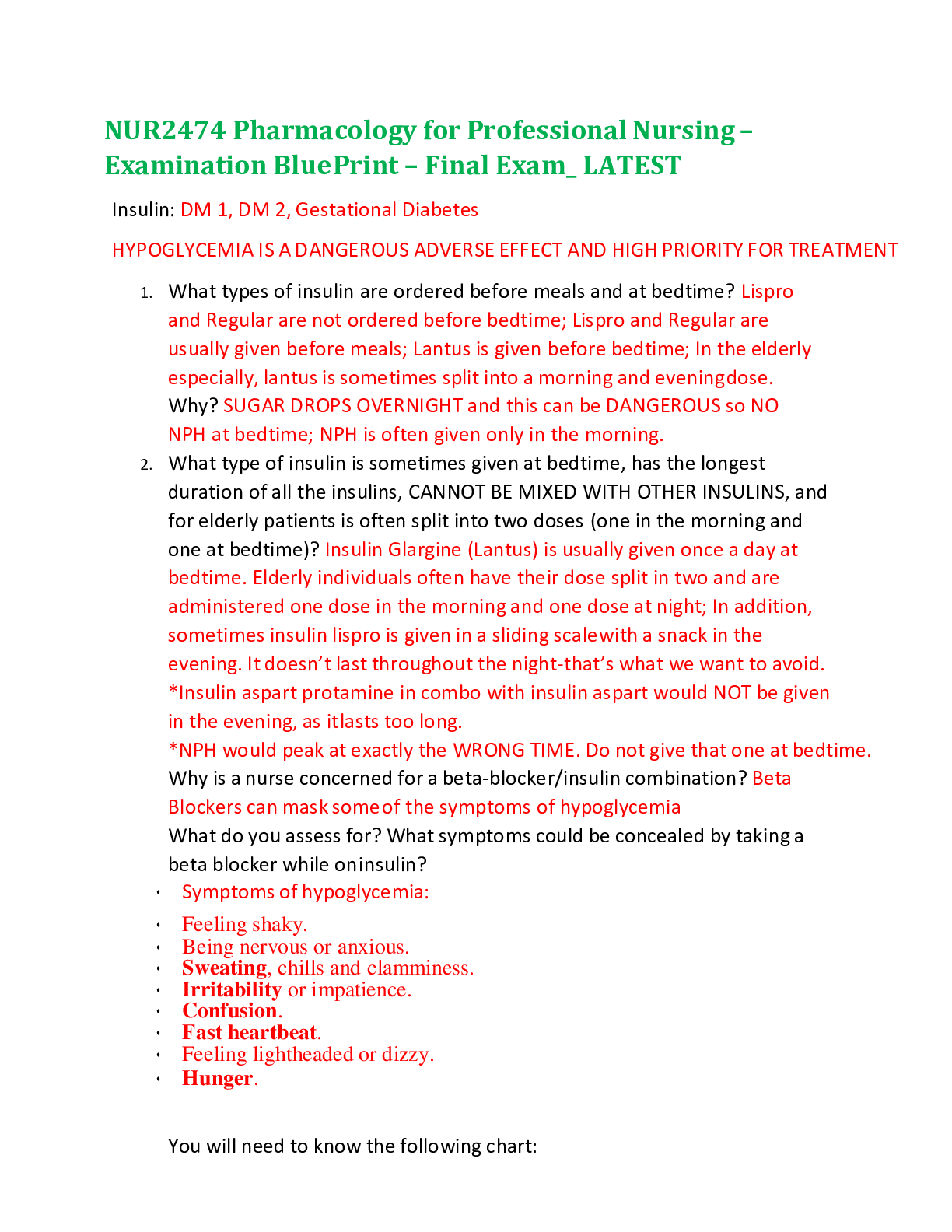
Reviews( 0 )
Document information
Connected school, study & course
About the document
Uploaded On
Mar 05, 2022
Number of pages
38
Written in
Additional information
This document has been written for:
Uploaded
Mar 05, 2022
Downloads
0
Views
24




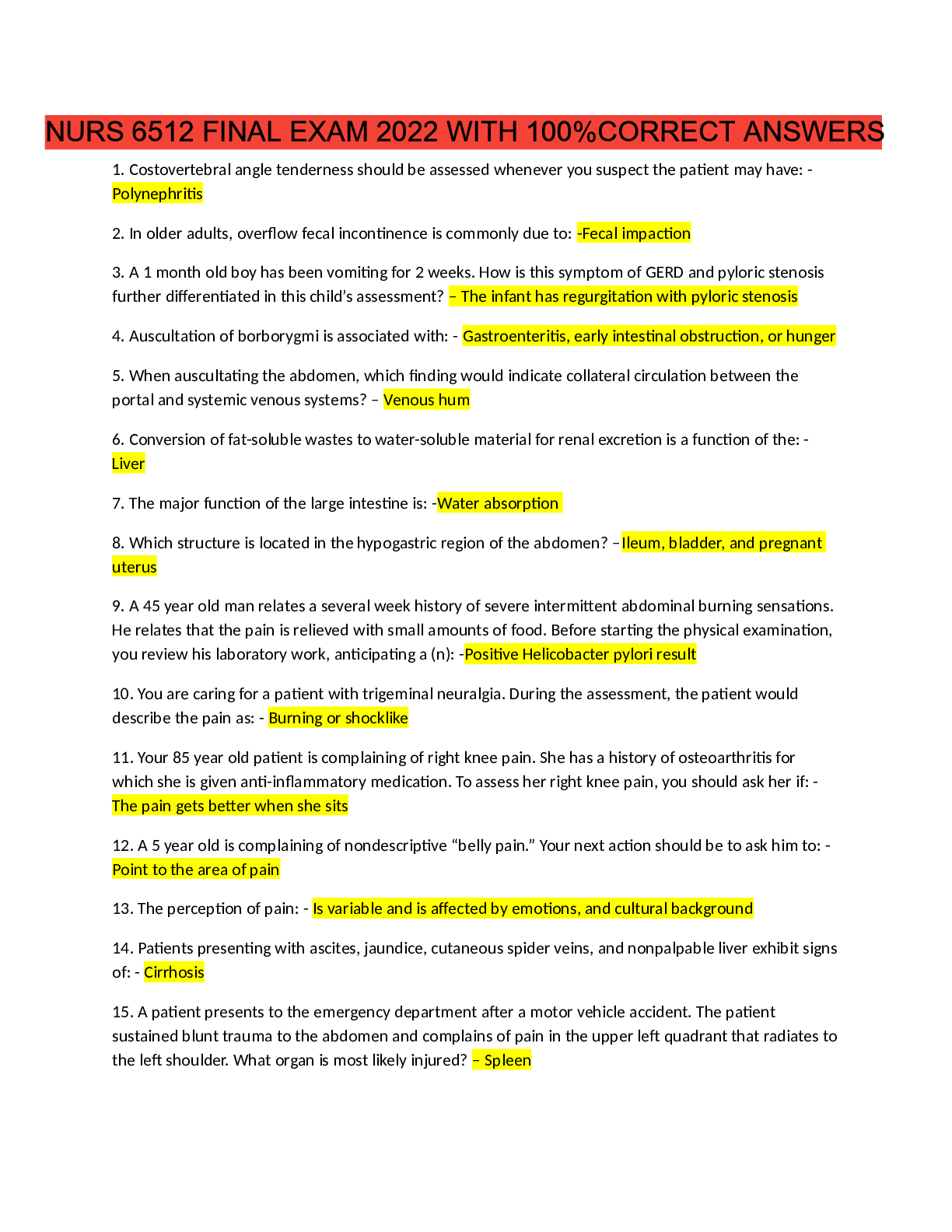

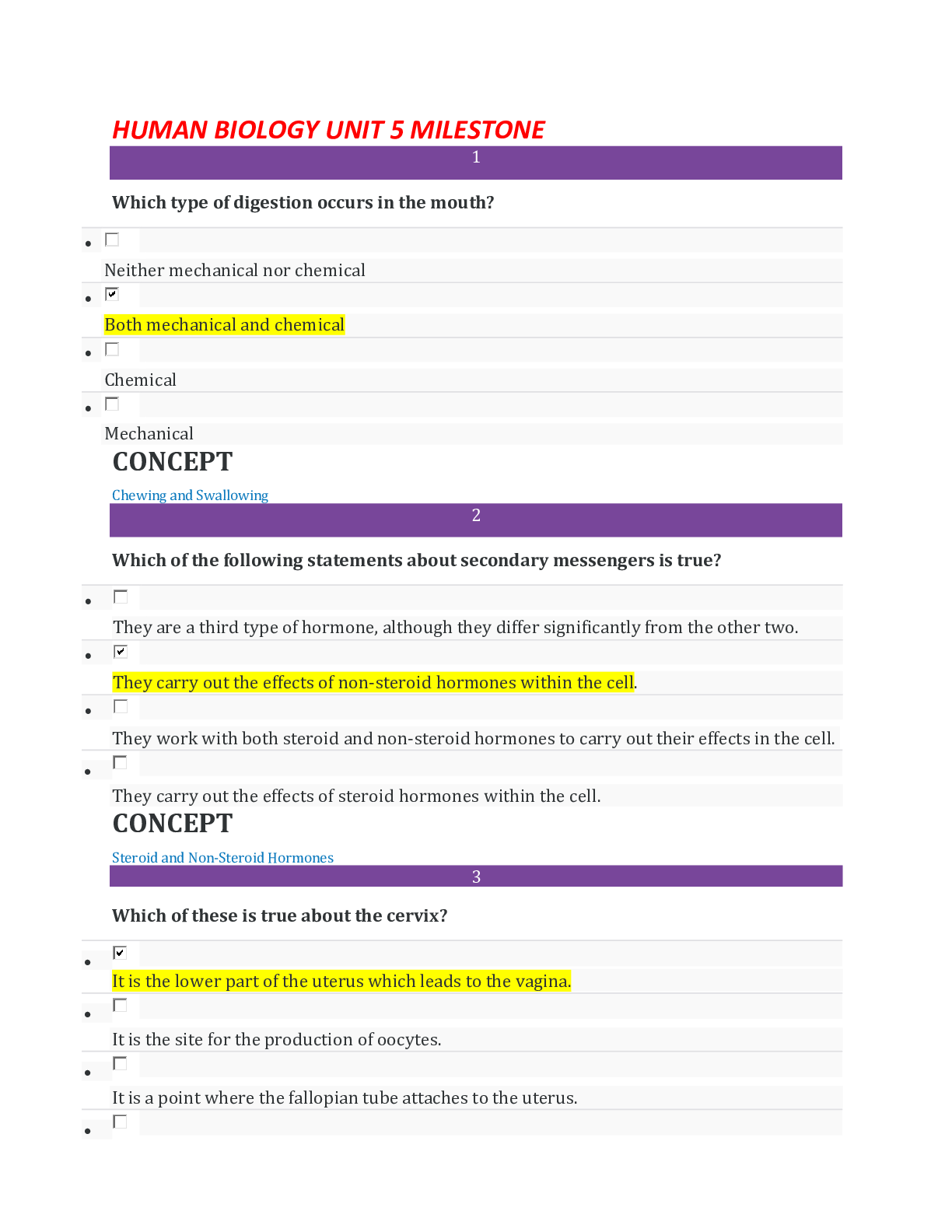










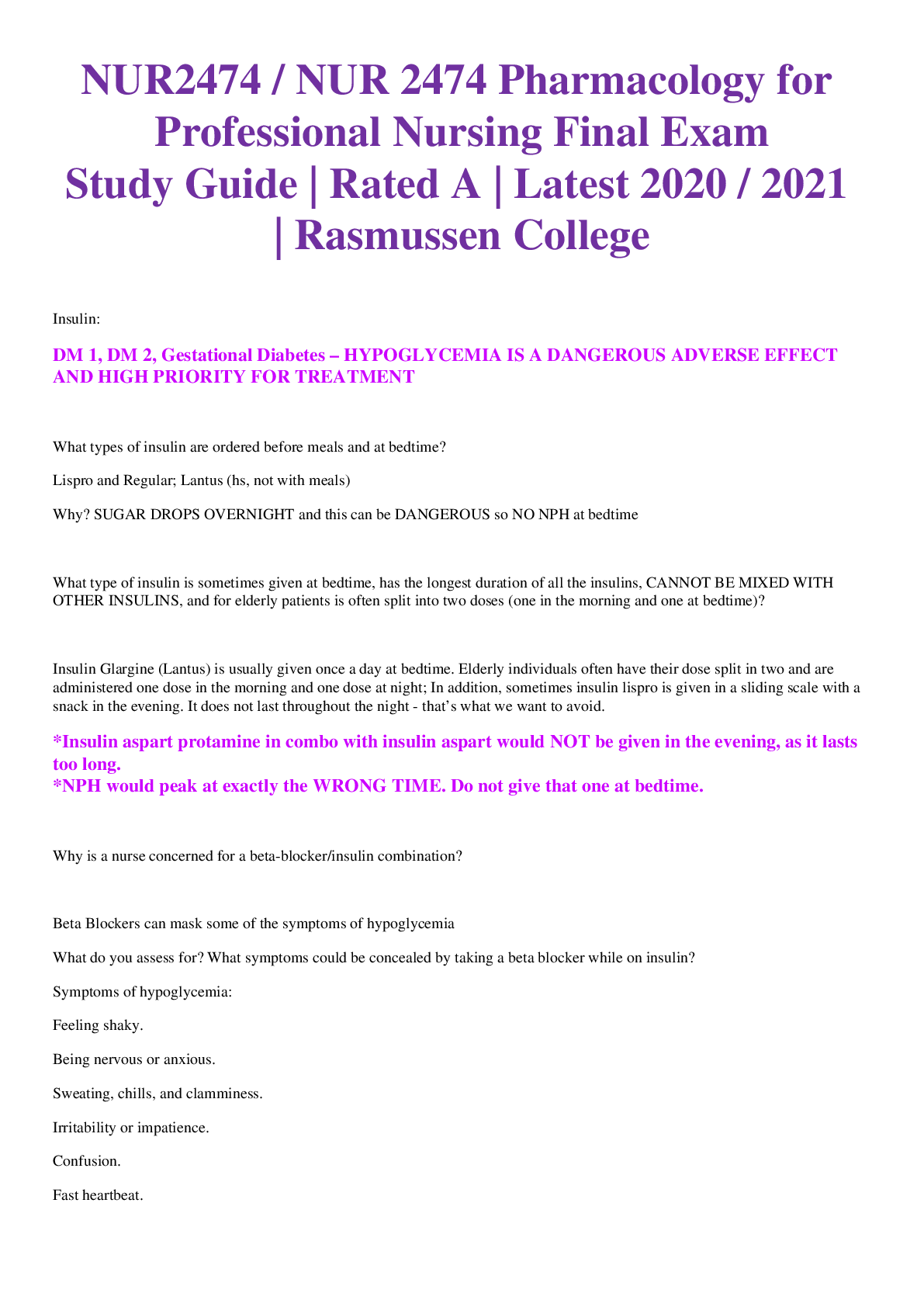


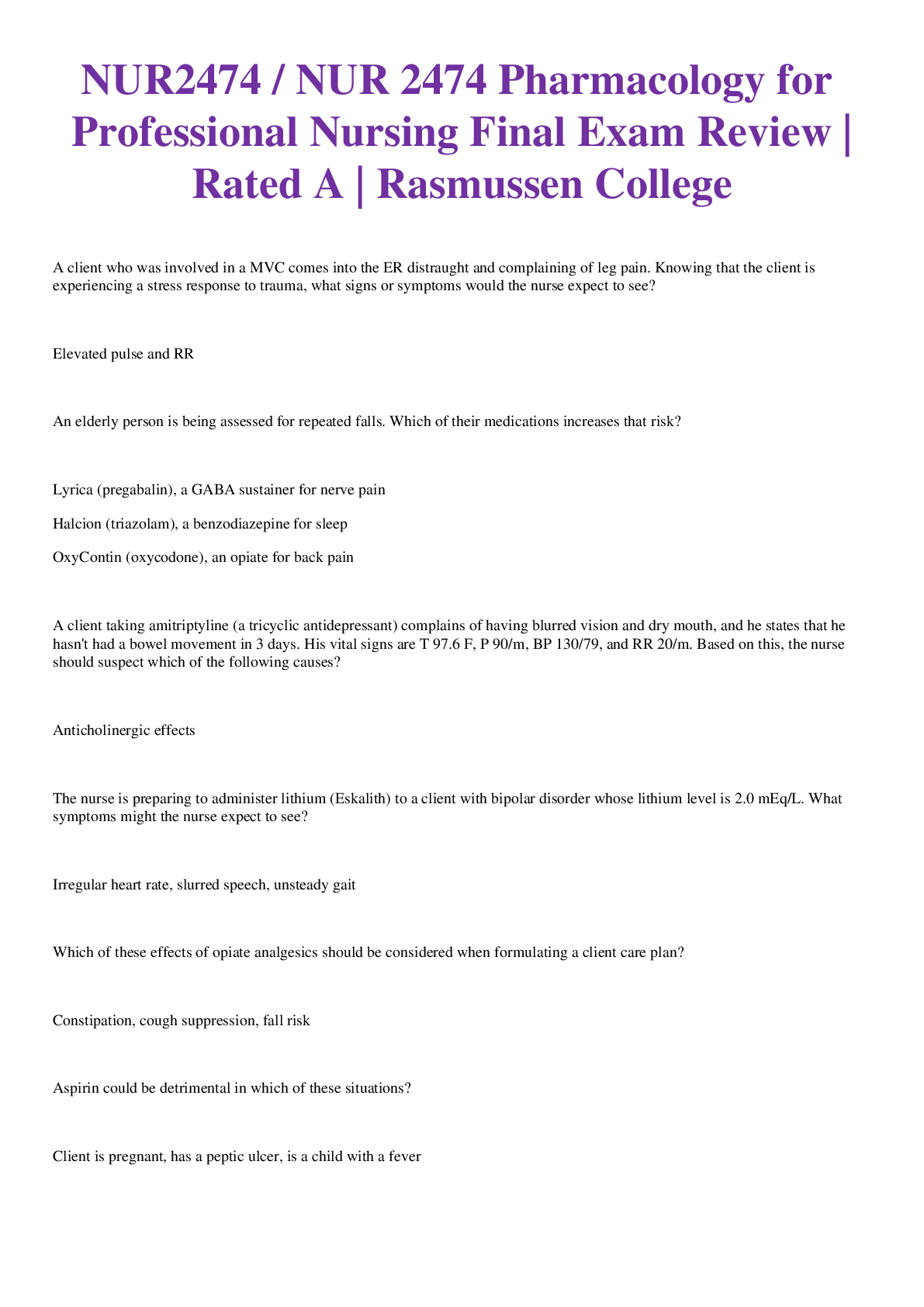

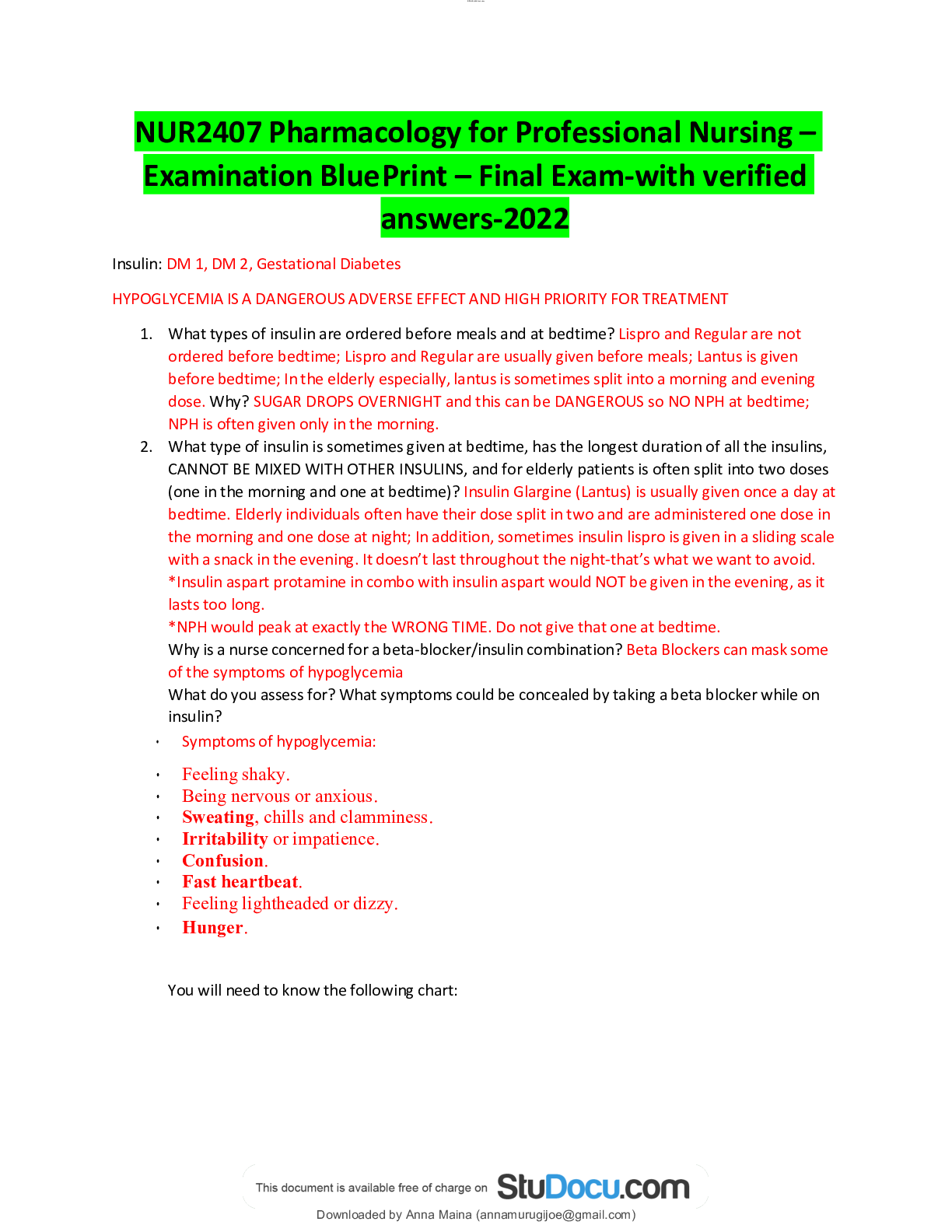

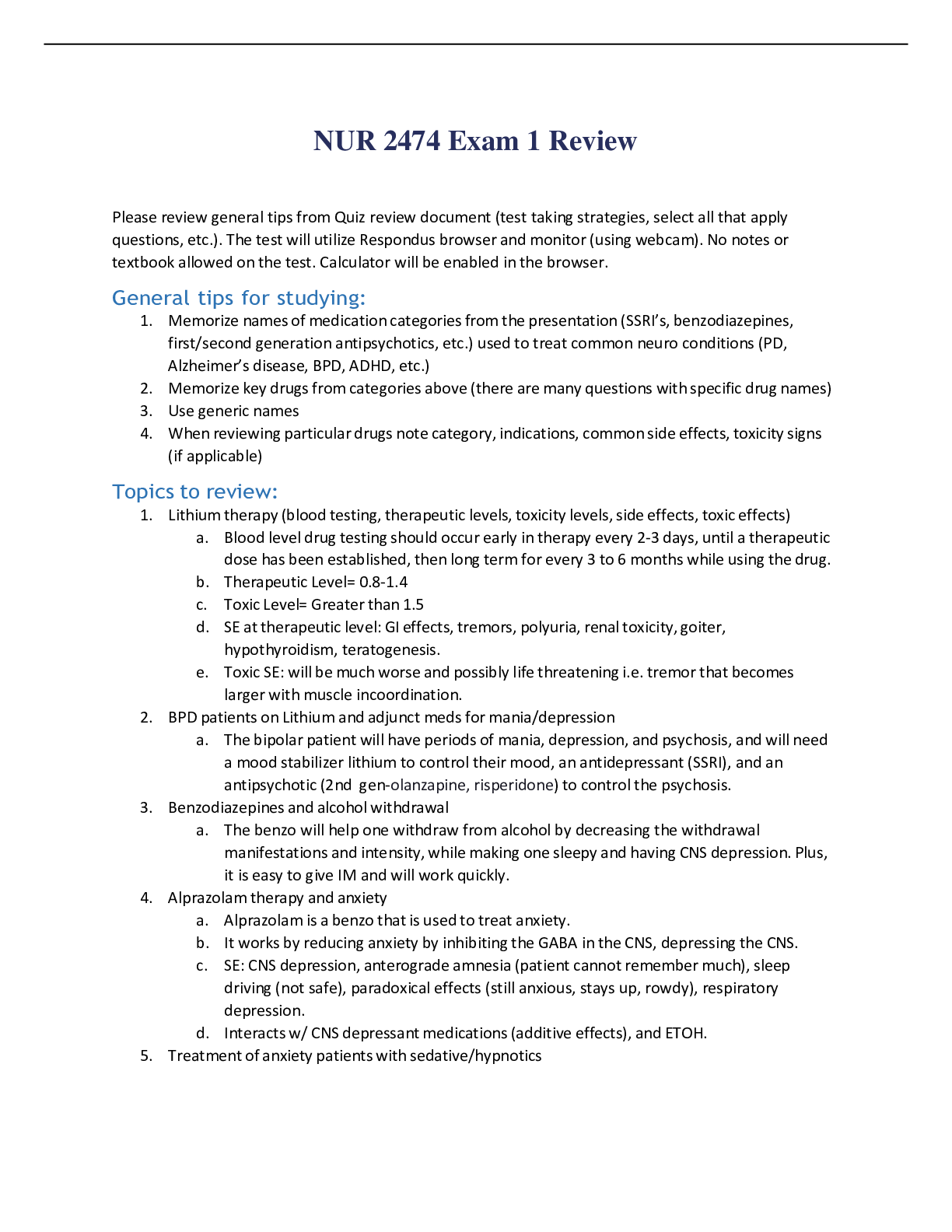
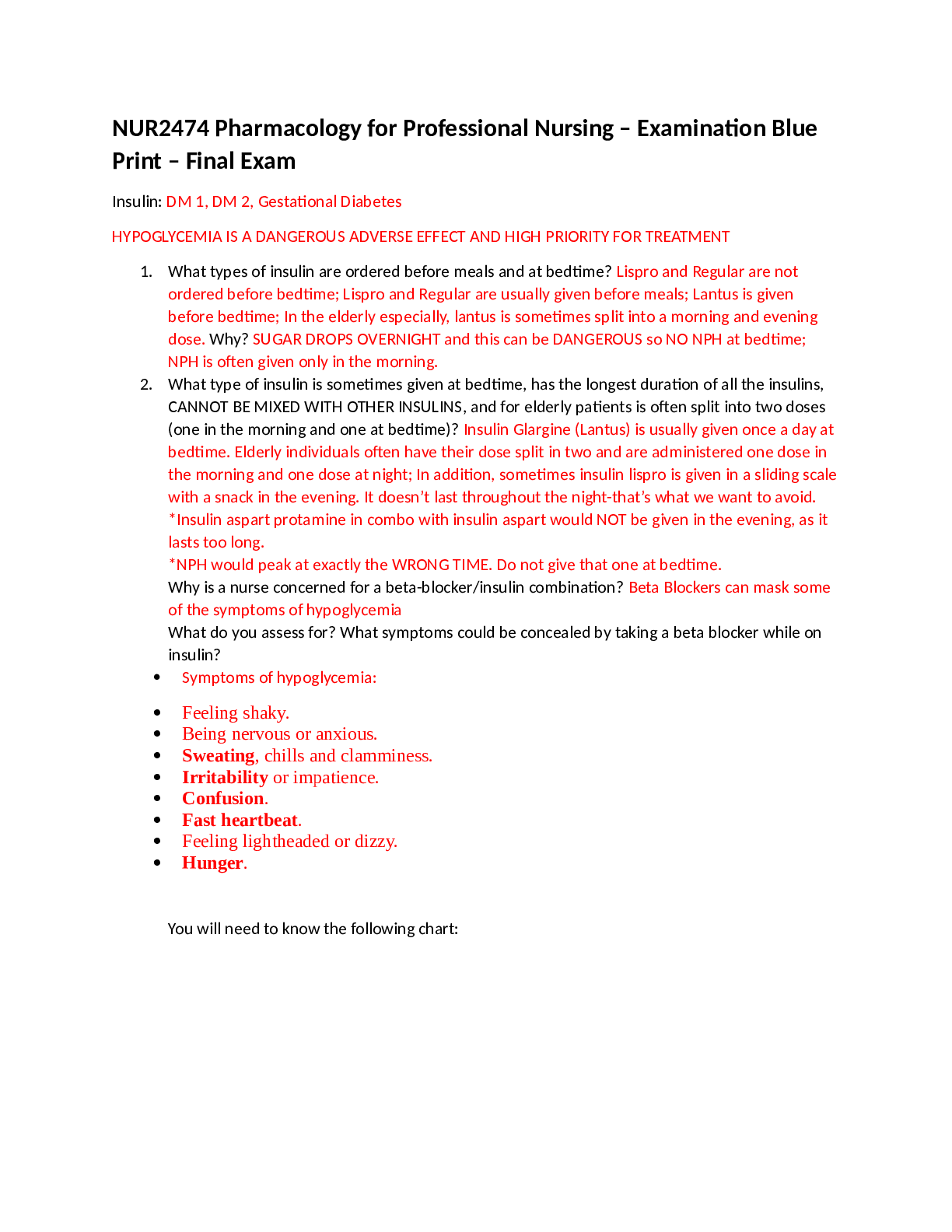

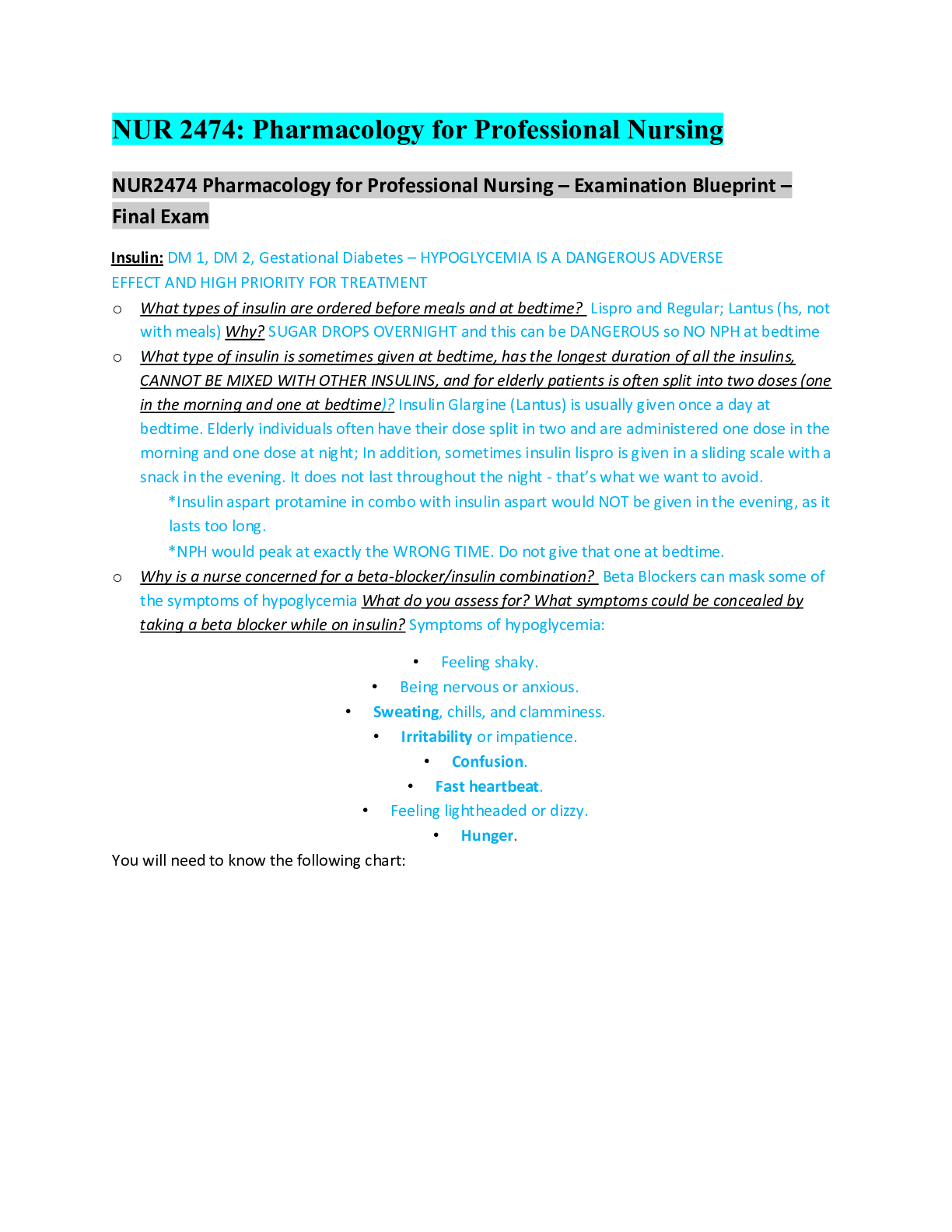
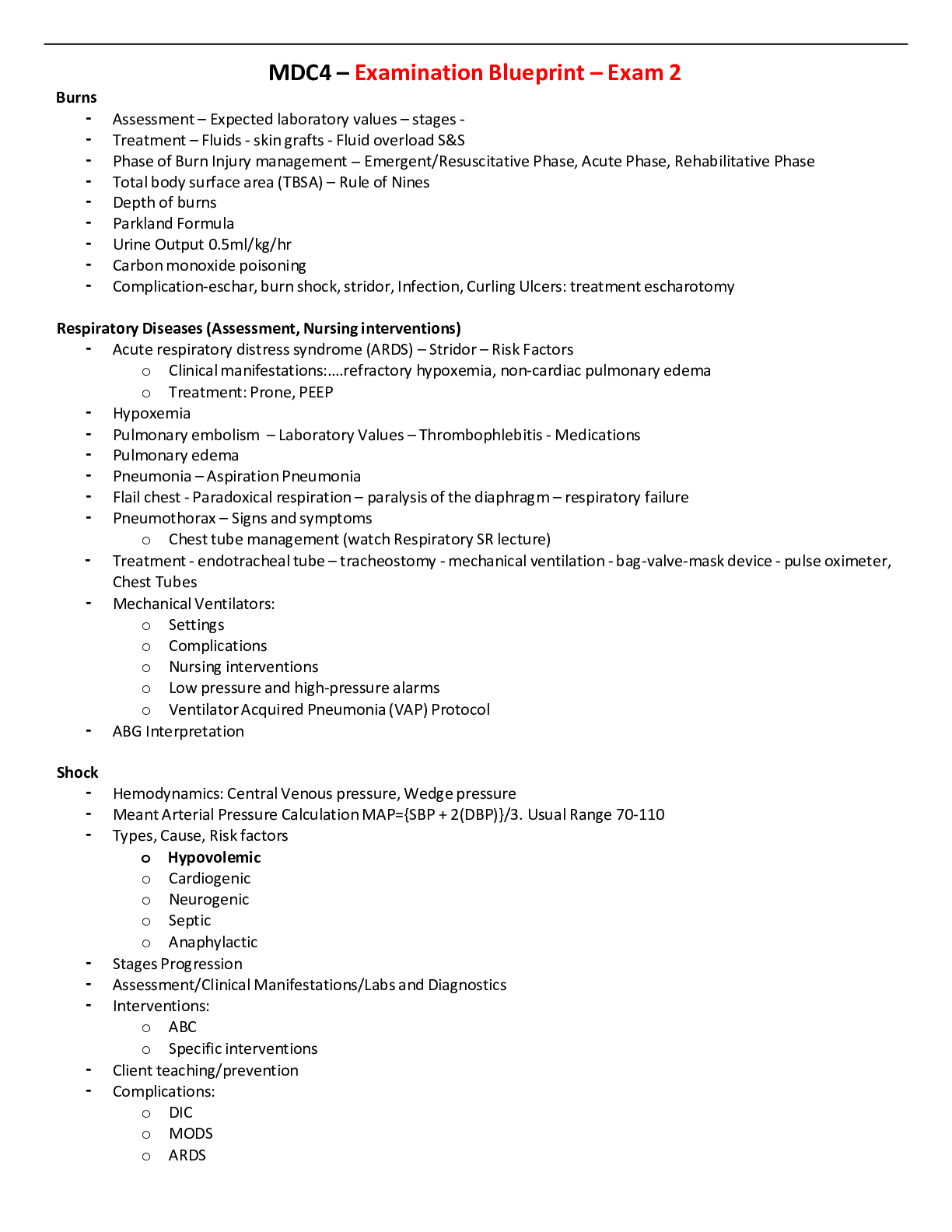
 Rasmussen.png)
 Pharmacology for Professional Nursing - Test #1 - Review.png)
